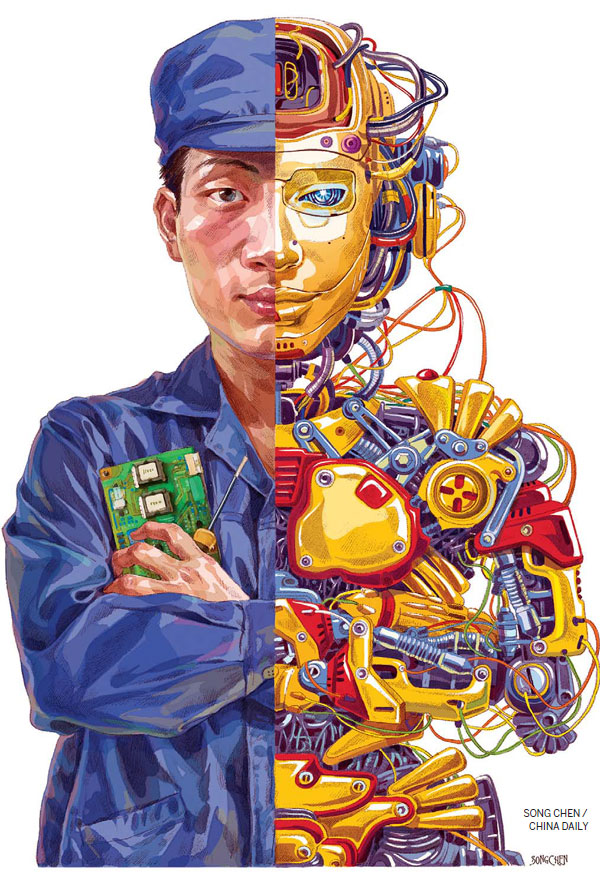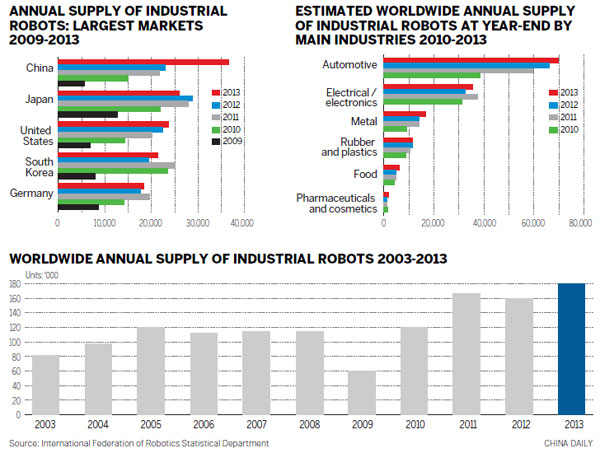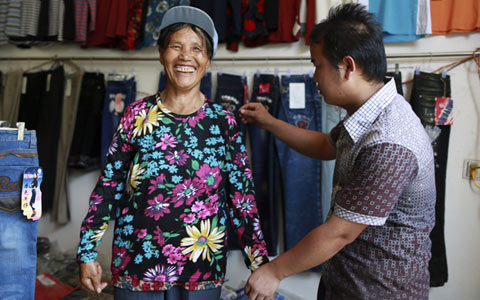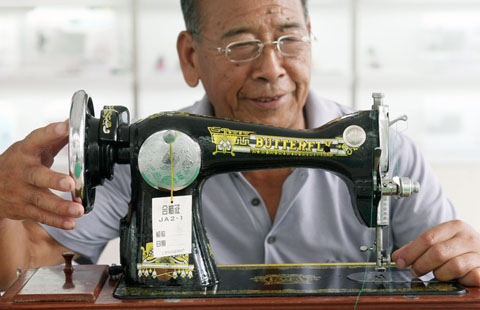

China has surpassed Japan to become the world's biggest, fastest-growing robot market
A worker sits making pullovers, while another next to her puts thread into her sewing machine.
What is special about this relationship is that one doesn't talk, eat, drink or even get paid.
"In the past, robots worked separately from humans, but now they can work together," said Arturo Baroncelli, president of the International Federation of Robotics, as he described the scene at the China International Robot Show in Shanghai recently.
"In future, there will be more interaction, more robots and humans working together."
For 30 years, businesses worldwide have flocked to China, attracted by its cheap labor.
But now, as this human labor force has begun to price itself out of the market, a new brigade of workers is being recruited to entice companies to the country: robots.
Not only will the shift have profound ramifications for the makeup of the workforce, Baroncelli says, but it has already turned the country into the world's biggest robot market.
"What happens here will shape the future of the world robot industry as a whole," he says.
Nearly 180,000 industrial robots were sold worldwide last year, a 12 percent increase on the previous year.
A fifth of those were installed in China, the federation revealed at its annual meeting during the show.
With sales of about 37,000 industrial robots last year, China surpassed Japan's 26,000 sales for the first time, to become the world's biggest and fastest growing market.
During the year, most Western robot markets grew by less than 10 percent, but China's total supply of industrial robots has now grown 36 percent annually on average over the past five years, says Li Xiaojia, a researcher at the China Robot Industry Alliance.
The alliance brings together 100 enterprises, manufacturers, universities and research institutes, and government-sponsored organizations involved in Chinese robotics research and development, manufacturing and services industries.
Over the next decade, Li expects the Chinese market to grow about 40 percent a year.
While Western countries started developing and using robots in the 1960s, China was a latecomer, but has caught up fast, meaning more overseas firms are anxious to establish a presence in the country.
Comau Group of Italy, for instance, a leader in automatic and flexible manufacturing systems, says it plans to transfer its robot production from Turin to Shanghai this year to be closer to customers.
Kuka AG of Germany, one of the world's leading suppliers of robotics as well as plant and systems engineering, opened its first overseas factory in Shanghai in March, which the company says will be able to produce 5,000 robots a year, a third of its production worldwide.
ABB Group of Switzerland, a major supplier of industrial motors and drives, entered China in 2005 and has already localized its whole robotic industry chain, including research, manufacturing and after sales.
"China has a huge number of factories that will need robots, but currently the density of robot use is about a third of the world's average, so we see great potential here," says Daisy Qi, product group head at ABB Engineering (Shanghai) Ltd.
Song Xiaogang, executive vice-president of the China Machinery Industry Federation, says the continuous rise in labor costs over the past few years has been the main driver for the booming robotics market.
"China's demographic dividend has been diminishing over the past few years. Labor costs have increased 15-20 percent every year," he says.
"This has had a massive impact on labor-intensive companies in traditional sectors, whose products are already delivering low profit margins."
Experts suggest the younger generation of industrial Chinese workers born in the 1980s and 1990s are also more choosy, not only about the work they do, but also about their working conditions, whether the environment is safe, toxic or harmful, for instance.
Many even refuse to work in what could be considered traditional manufacturing industries, regardless of payment.
National Bureau of Statistics figures show an aging population is adding to the industrial tension.
In 2012, China's working population was 937 million, 3.45 million less than in 2011, and last year the number fell further to 920 million, accounting for about 67.6 percent of the entire population.
"The working population will continue to fall, so using robots has become an important tool to help companies maintain or improve their productivity," says Song, adding that robots are also better at doing repetitive, tedious and dangerous work.

The three-day Shanghai robot show last month not only attracted 216 companies from more than 18 countries and regions, but also 38,572 visitors, a jump on last year's 27,371, showing the increased use of robots is capturing the public's imagination too.
Shen Hongwen, deputy general manager of Yuzhou Yilan Copper and Aluminum Industry Co Ltd of Henan province, says his company plans to invest millions in robots this year.
"A worker's wage is about 3,000 ($480, 360 euros) to 4,000 yuan a month, and is increasing.
"A robot that costs about 200,000 yuan is equally capable of doing the work of five workers, and that cost can be recovered in just one or two years."
As industrial China continues to transform and upgrade in search of better margins, the demand for robots is expected to rise, particularly in the country's manufacturing heartlands.
Traditional labor-intensive industries have been encouraged to diversify, or at the least operate in a more sustainable, environmentally friendly way.
"Industrial transformation means higher dependence on automation and precision, and the robot is the perfect tool for that," Song says.
"The Chinese manufacturing sector has huge scale and diversity, much of which needs upgrading. That's why the market is growing so quickly."
Foxconn, the major supplier of components to Apple Inc in China, has vowed to use more robots in its various manufacturing operations across the country, to replace dangerous, boring and repetitive work.
The company is building a research and manufacturing hub in Guiyang, the capital of Guizhou.
Terry Gou, its chairman, said last month that its operations in the city's new industrial park were expected to generate revenue of 50 billion yuan in 2018.
In 2011, Foxconn revealed it planned to be using a million robots in its factories within three years, and to have its factories fully automated within a decade.
Some top Chinese home appliance brands have also been employing robotic technology on a major scale.
Haier Group, the multinational electronics giant, is reported to have cut 18 percent of its workforce last year and will cut another 10,000 positions this year, due to its increased use of robots.
Midea, the privately held Chinese electrical appliance manufacturer, has also set up robot design and manufacturing teams, and already uses hundreds of robots on its production lines.
Noting the trend, the Chinese authorities have introduced policies to encourage more use of robotics.
In December, the Ministry of Industry and Information Technology issued guidelines for promoting the use of industrial robots.
And in June, at the 17th conference of the Chinese Academy of Sciences, the national institution conducting basic and applied research, President Xi Jinping stressed that "major robot manufacturers and countries are speeding up their market development, so our companies should also improve their robot-related skills".
In Qingdao, Shandong province, an industrial park has been set up dedicated to the robot sector.
Opened in May last year, it has already attracted 30 companies and startups. Its target is 50 by 2016, generating output value of about 4 billion yuan.
"The robot industry is a way of promoting the whole city's industrial transformation and upgrade," says Geng Kai, deputy director of the Bureau of Investment Promotion at Qingdao National High-tech Industrial Development Zone.
"Qingdao has a good industrial foundation. Our machinery and equipment sector, which boasts many top appliance and food brands, had output exceeding 250 billion yuan last year.
"As a coastal city, we also have good natural conditions for developing various other marine-related robots, which could work underwater."
Further south in Zhejiang province, known for exports largely dependent on low-cost labor, 36,000 local companies have already stated they plan to replace workers with machines by 2017, at a total investment expected to be more than 300 billion yuan.
Similar estimates have been published by officials in Guangdong province, the mighty export manufacturing hub in the south of China, and in Jiangsu province, home to many of the world's leading exporters of electronic equipment, chemicals and textiles.
However, overseas-made robots still dominate.
Of those 37,000 sold in China last year, only 9,000 were from Chinese suppliers.
Local sales were three times higher than in the previous year, while the sales of foreign suppliers rose 20 percent, the China Robot Industry Alliance says.
But Japanese, European and US producers still accounted for the majority of major contracts, with Chinese products being targeted mostly at middle and low-end users.
"Robots made by Chinese suppliers still lag behind those made by international companies, in terms of quality, technical level and performance parameters," Song says.
"Moreover, core components, which account for more than 60 percent of the whole cost, are mainly bought from international companies."
Song says about 60 percent of the robot population is being used in the automobile industry, meaning huge potential for various other industries.
While automotive demand will also increase, he sees fast growth to come in the computer, communication and consumer electronic industries, as well as food and beverage, biological medicine and the service industries.
"China has many industries that other countries do not have, for example, pottery and hardware manufacture, where huge opportunities exist", he says.
A meeting held at last month's robot show between leading members of the International Federation of Robotics and the China Robot Industry Alliance agreed that while overseas and Chinese companies continue to target different levels of the market, a strong joint effort has to be made to continue developing the local robot sector.
However, the rapid expansion of the industry in China does present worries for some experts.
Li Boji, assistant general manager of GSK CNC Equipment Co Ltd, the Guangzhou-based supplier of advanced machine tools and computer numerical control equipment, says robot use is still new to many of his Chinese customers.
He is concerned that as more Chinese companies dip their toes in the market, there could be an overcapacity of low-end robots, meaning a dramatic fall in prices and quality.
"If first-time buyers opt for low-quality robots that break down frequently, that could hurt the industry's credibility," he says.
"We don't want too many companies entering the market, blindly offering the same types of product. That will hurt the normal development of the industry."
Qu Daokui, president of Siasun Robot and Automation Co Ltd, says the biggest challenge for Chinese companies is how to improve technology and product performance.
Siasun, founded in 2000, is considered China's largest robot company, with a market value of about 19.3 billion yuan. It has 1,000 R&D staff, and invests about 10 percent of its annual income on R&D, Qu says.
"We own the property rights to all our products and technology," Qu says.
"We put dozens of new robots onto the market every year and own the patents to hundreds."
Siasun's products are mainly targeted at the middle and high-end of the market and have been exported to about 13 countries through business partners.
Siasun, with a new international office in Shanghai, entered into agreements with universities and research institutes, and Qu says the company is now looking at possible international mergers or acquisitions.
Stefan Sack, the CEO of the Italian-owned Comau Shanghai Engineering Co Ltd, says companies of all sizes should think carefully before investing in the robot market.
The Chinese market is still short of qualified and experienced robotics engineers, he says.
"There are risks if we overlook that, and just focus on increasing robot manufacturing.
"What needs to be funded is education of technicians to help build this quick-growing market, not building more robot companies."
With this in mind, Nachi (Shanghai) Co Ltd, a Japanese-owned robot manufacturer, launched its first technology center in Shanghai last month, offering professional training and after-sales services, and a venue for new systems experiments.
The center is expected to cost at least a million yuan a year to run, and it says more centers are planned around the country, one of which will be in Guangzhou.
"Our aim is to make sure that wherever our customers are, they can easily find a technology center nearby," says Liu Xiaobing, deputy general manager of the new center.
Li Boji adds that GSK also established a similar center last year, and now employs about 60 technicians offering tailored service to its Chinese customers. It, too, injects more than 10 percent of its income into funding R&D.
"Robotics is a personalized service, and every customer has different requirements and needs different components," Li says.
Song of the China Machinery Industry Federation says that as a third-party association, it wants companies and government departments to maintain a sensible attitude toward the industry.
Its healthy development relies on manufacturers, integrators and users working together, he says.
Given the sheer size of the Chinese market, domestic producers and developers have a huge advantage over international suppliers, he says, in that they understand the varied needs of different industries in China far better than international suppliers.
"They should focus on special areas and niches at this stage, and if they do that well, they are very likely to achieve great success."
chenyingqun@chinadaily.com.cn
|
The China International Robot Show in Shanghai last month. Gao Erqiang / China Daily |

(China Daily Africa Weekly 08/08/2014 page1)








